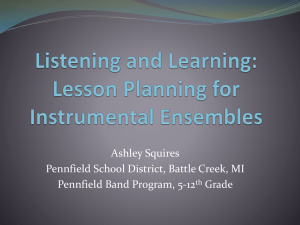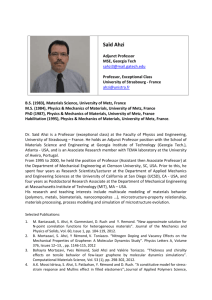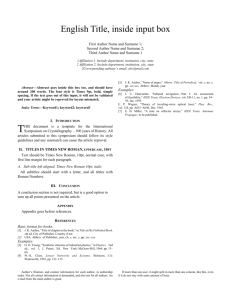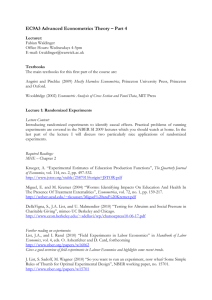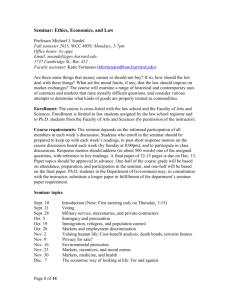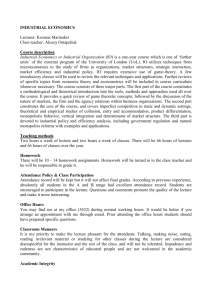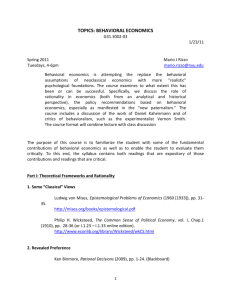view syllabus
advertisement
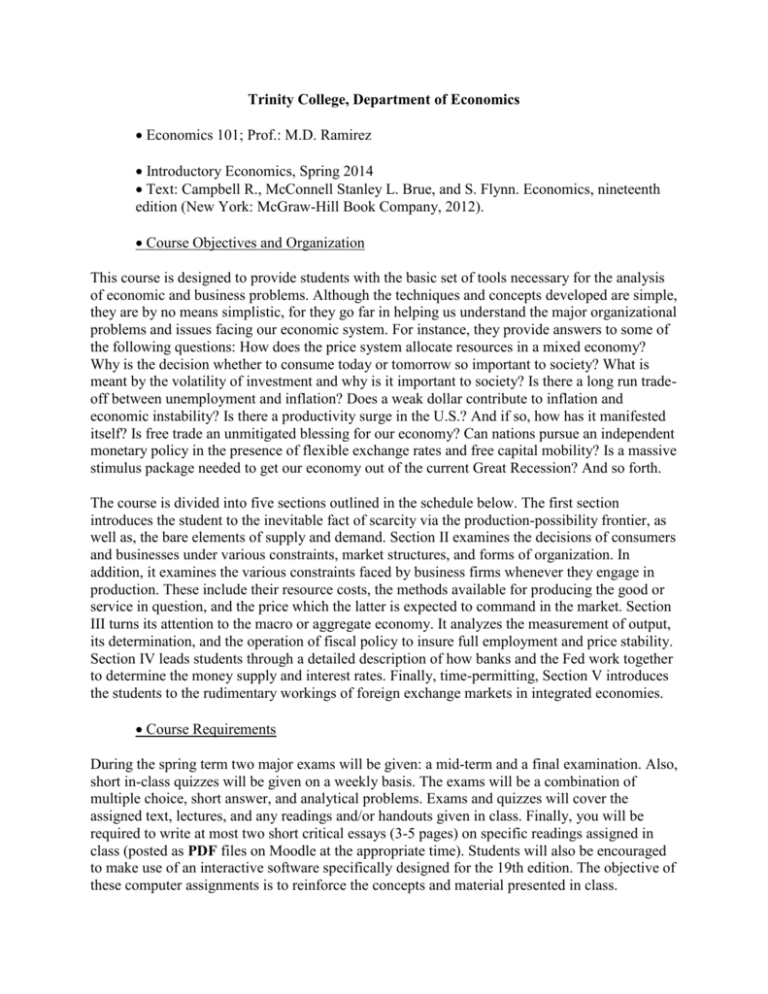
Trinity College, Department of Economics Economics 101; Prof.: M.D. Ramirez Introductory Economics, Spring 2014 Text: Campbell R., McConnell Stanley L. Brue, and S. Flynn. Economics, nineteenth edition (New York: McGraw-Hill Book Company, 2012). Course Objectives and Organization This course is designed to provide students with the basic set of tools necessary for the analysis of economic and business problems. Although the techniques and concepts developed are simple, they are by no means simplistic, for they go far in helping us understand the major organizational problems and issues facing our economic system. For instance, they provide answers to some of the following questions: How does the price system allocate resources in a mixed economy? Why is the decision whether to consume today or tomorrow so important to society? What is meant by the volatility of investment and why is it important to society? Is there a long run tradeoff between unemployment and inflation? Does a weak dollar contribute to inflation and economic instability? Is there a productivity surge in the U.S.? And if so, how has it manifested itself? Is free trade an unmitigated blessing for our economy? Can nations pursue an independent monetary policy in the presence of flexible exchange rates and free capital mobility? Is a massive stimulus package needed to get our economy out of the current Great Recession? And so forth. The course is divided into five sections outlined in the schedule below. The first section introduces the student to the inevitable fact of scarcity via the production-possibility frontier, as well as, the bare elements of supply and demand. Section II examines the decisions of consumers and businesses under various constraints, market structures, and forms of organization. In addition, it examines the various constraints faced by business firms whenever they engage in production. These include their resource costs, the methods available for producing the good or service in question, and the price which the latter is expected to command in the market. Section III turns its attention to the macro or aggregate economy. It analyzes the measurement of output, its determination, and the operation of fiscal policy to insure full employment and price stability. Section IV leads students through a detailed description of how banks and the Fed work together to determine the money supply and interest rates. Finally, time-permitting, Section V introduces the students to the rudimentary workings of foreign exchange markets in integrated economies. Course Requirements During the spring term two major exams will be given: a mid-term and a final examination. Also, short in-class quizzes will be given on a weekly basis. The exams will be a combination of multiple choice, short answer, and analytical problems. Exams and quizzes will cover the assigned text, lectures, and any readings and/or handouts given in class. Finally, you will be required to write at most two short critical essays (3-5 pages) on specific readings assigned in class (posted as PDF files on Moodle at the appropriate time). Students will also be encouraged to make use of an interactive software specifically designed for the 19th edition. The objective of these computer assignments is to reinforce the concepts and material presented in class. Course Grades The tentative weights and dates of the components of your final grade are as follows: Weight (%) Mid-term Exam: Final Exam: a.m.) In-class quizzes: Homework and reviews: Attendance and participation Dates 30 35 Mid-term: October 21st (T) Final-Exam: Dec. 17th (W at 9:00 15 15 5 Given weekly on Th (12 minutes) Office Hours My office is located in Williams Building, Room 227, and I will be available for consultation on M between 10:30 and 11:15 and W between 10:00 and 11:50, and by appt. My office phone number is 297-2487. I will only accept telephone messages on my message center for extremely urgent reasons such as missing an exam or not turning in a quiz by the assigned date. Please turn off cell phones, laptops, i-phones, etc., and refrain from getting up in class--it is both disruptive to class discussion and poor manners to your fellow students and instructor. E-mail messages are welcome as long as they pertain to substantive topics related to class material. My email is: Miguel.Ramirez@trincoll.edu Schedule I. Basic Concepts (approx. 4 weeks: September 2nd—Sept. 25th). Required Reading: McConnell, Economics, Chps. 1-3 and 4. Suggested Reading: Beitel, Karl, "The Subprime Debacle," Monthly Review, Vol. 60, No. 1, May 2008, pp. 27-44; Foster, John. B., "The Financialization of Capital and the Crisis," Monthly Review, Vol. 59, No. 11, April, 2008, pp. 1-19. (Final day to withdraw from fall term courses is Friday February 14th). Suggested Reading: Stephen P.A. Brown, "Crude Awakening: Behind the Surge in Oil Prices," Economic Letter, Vol. 3, No. 5, May 2008, pp. 1-8; and Michael D. Plante, "Did Speculation Drive Oil Prices?" Economic Letter, Vol. 6, No. 11, October 2011, pp. 1-4; Michael D. Plante, "Market Expectations and Corn Prices," Economic Letter, Vol. 7, No. 7, August 2012, pp. 1-4. II. Microeconomics (approx. 4 weeks: Sept. 30th—October 23rd). Required Reading: McConnell, Economics, Chps. 6-11, and Appendix 6. Suggested Reading: Orrenius, Pia, "Immigrant Assimilation: Is the U.S. Still a Melting Pot?" Fed. Reserve Band of Dallas, Southwest Economy, Issue 3, May/ June 2004, pp. 1-6."U.S. Immigration and Economic Growth: Putting Policy on Hold," Southwest Economy, Issue 6, November/December 2003, pp. 1-7; Mike Nicholson and Pia Orrenius, : Manning the Gates: Migration Policy in the Great Recession," Vol. 5, No. 5, June 2010, pp.1-8. (Trinity days: October 13th and 14th .) Mid-term Exam: October 21st (T). III. Macroeconomics (approx. 4 weeks: October 28th—November 20th) Required Reading: McConnell, Economics, Chps. 23-24, and 27-30. Suggested Readings: Schreft, Stacey L., "Jobless Recoveries and the Wait-and-See Hypothesis," Economic Review, Fourth Quarter 2005, pp.81-99; Enrique MartinezGarcia, "A Historical Look at the Labor Market During Recessions," Economic Letter; Vol. 5, no.1, January 2010, pp. 1-8; Edward S. Knotek and Stephen Terry, "How will Unemployment Fare Following the Recession?", Economic Review, Third Quarter 2009, Vol. 94, No. 3, pp.7-30 and Keynes, John M., The General Theory of Employment, Interest and Money, Chps 2-3, and 12; Thanksgiving vacation: Nov. 26th—Nov. 30th . IV. Money, Interest Rates, and Monetary Policy (1 week: Nov.25th –December 1st) Required Reading: McConnell, Economics, Chps. 31and 32. Suggested Readings: Danielle DiMartino Booth and J.J. Renier, "Fed Policy in the Financial Crisis: Arresting the Adverse Feedback Loop," Economic Letter, Vol. 4, No. 7, September 2009, pp. 1-8; Chad R. Wilkerson, "Recession and Recovery Across the Nation: Lessons from History," Economic Review, Second Quarter 2009, Vol. 94, No. 2, pp.103-122; Harry Rosenblum, "Regulatory and Monetary policies Meet 'Too Big to Fail,'" Economic Letter, Vol. 5, No. 3, April 2010, pp. 1-8. V. Open-Economy Macroeconomics (approx. 1 week: Dec. 1st –Dec. 4th ) Required Reading: McConnell, Economics, Chp 38 . Classes end on April 30th (W). Suggested Readings: Mark A Wynne and E.K. Kersting, "Trade, Globalization and the Financial Crisis," Economic Letter, Vol. 4, No. 8, November 2009, pp. 1-8. and Simona E. Cociuba, "Upstream Capital Flows: Why Emerging Markets Send Savings to Advanced Economies?" Economic Letters, Vol. 6, No. 5, May 2011, pp.1-4. Last day of classes: Dec. 4th (Th).


